Vauxhall Opel Astra G
| 1998 to 2005 | |
|---|---|
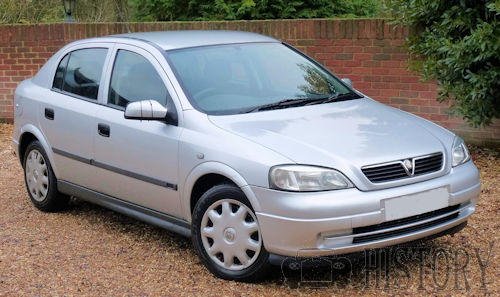 |
|
| Overview | |
| Also called | Chevrolet Astra Chevrolet Viva Holden Astra Vauxhall Astra Opel Astra Classic II |
| Production | 1998–2009 (Opel) 1998–2011 (Chevrolet) |
| Body and chassis | |
| Class | Small family car (C) |
| Body style | 3-door hatchback 5-door hatchback 4-door saloon 5-door estate 2-door cabriolet 2-door coupé 3-door car derived van |
| Platform | T-body platform |
| Related | Opel Zafira A |
| Powertrain | |
| Engine | 1.2 L X12XE I4 (petrol) 1.2 L Z12XE I4 (petrol) 1.4 L X14XE I4 (petrol) 1.4 L Z14XE I4 (petrol) 1.6 L X16SZR I4 (petrol) 1.6 L Z16SE I4 (petrol) 1.6 L X16XEL I4 (petrol) 1.6 L Z16XE I4 (petrol) 1.7 L TD I4 8V 1.7 L DTi I4 16V 1.8 L X18XE1 I4 (petrol) 1.8 L Z18XE I4 (petrol) 2.0 L X20XEV I4 (petrol) 2.0 L X20XER I4 (petrol) 2.0 L Z20LET I4 (turbocharged petrol) 2.0 L Di I4 16V 2.0 L DTi I4 16V 2.2 L Z22SE I4 (petrol) 2.2 L DTi I4 16V 2.4 L I4 |
| Transmission | 5-speed manual 4-speed automatic 5-speed automatic |
| Dimensions | |
| Wheelbase | 2,606 mm (102.6 in) Wagon: 2,611 mm (102.8 in) |
| Length | Hatch: 4,110 mm (161.8 in) Saloon: 4,252 mm (167.4 in) Estate: 4,288 mm (168.8 in) Convertible: 4,267 mm (168.0 in) |
| Width | 1,709 mm (67.3 in) |
| Height | 1,425 mm (56.1 in) Cabriolet: 1,390 mm (54.7 in) |
The Astra G was launched in Europe in 1998. It was available as a 3-door liftback and 5-door liftback, 4-door saloon, 5-door estate (in Opel tradition, known as a "Caravan") and two special versions from 2000: the Astra Coupé and the Astra Cabrio, both of them designed and built by Bertone. The Astra G saw the introduction of a natural gas-powered engine. Its chassis was tuned by Lotus and formed the base of a 7-seater compact MPV, the Opel Zafira. Approximately 90,000 coupés were produced, of which 7000 were cabriolets.
As standard there was power steering , four airbags (for export none or only two airbags), ABS (export partly without) and an immobilizer .
Optional equipment or in certain versions series were air conditioning, front electric windows, electric mirrors, radio, central locking with remote control, xenon, multi-info display.
For an additional charge were various extras such as climate control , navigation system , traction control or xenon headlights available and an electronic 4-speed automatic transmission.
The Astra G was the first Opel to be offered with a fully galvanized body (until model year 2001, then partially galvanized), 12 years rust-through warranty and partial gold leaf trim.
Model Variants
- Three- and five-door hatchback (CC), vehicle type: T98 (March 1998 to March 2004)
- four-door saloon (sedan), vehicle type: T98 / NB (July 1998-March 2004)
- five-door station wagon (caravan), type of vehicle: T98 / station wagon (March 1998 to July 2004, as CNG until January 2005 )
- two-door coupé , vehicle type: T98C (March 2000 to December 2004)
- two-door convertible , vehicle type: T98C (March 2001 to December 2005)
- Two-door delivery van, vehicle type: Van
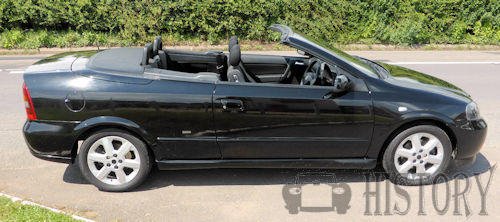
The manufacturing of the Astra Saloon continued at Opel's Gliwice plant in Poland after the debut of the next-generation Astra H, with the older model being branded as Astra Classic in a similar fashion to its predecessor, catering to the lower end of the market. This car was offered in Central and Eastern Europe, as well as Turkey with the name Astra Classic II from 2004 to the end 2009. Apart from European markets, these models were sold in Australia and New Zealand as Holden Astra Classic, until they were replaced by the Holden Viva in 2006The Astra G was built as Chevrolet Astra in Brazil. It was facelifted in 2003, and was sold in Brazil, Argentina, Mexico, and other Latin American markets until 2011. The GM Brazilian 2.0 8V I4 engine which equips the Astra has the "flexpower" technology, that allows the car to run on both petrol/alcohol fuels, providing 128/140 hp (G/A) at 5200 rpm.
A taxi version of the Brazilian sourced model, powered with gasoline 2.0 engine was sold in Chile as the Chevy Urban.
In 2004, GM's Russian joint venture GM-AvtoVAZ launched the 4-door version of the Astra G as the Chevrolet Viva. It was sold through Chevrolet dealers in Russia, while Opel dealers were selling the newer Opel Astra H. Sales were poor from the start due to high pricing: the only version launched was equipped with a 1.8L engine with an above-average trim level, placing the Viva's price above the Toyota Corolla. A project costing $340 million was selling less than a thousand cars annually (801 cars in 2007); rumours of shutting down Chevy Viva production circulated as early as summer of 2005. GM-AvtoVAZ shut down small-scale production of the Viva in March 2008.
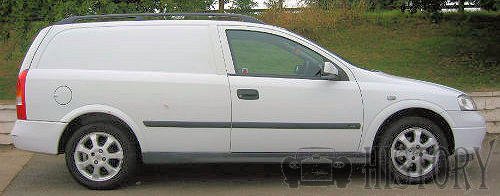
Cabriolet
The convertible was designed as well as the coupe at Bertone in Italy (quote: "conceived by Opel, created by Bertone") and manufactured from March 2001.
It is a four-seater convertible with soft top , the space in the rear - as usual in such vehicles - does not consist of full seats. The roof is a solid trough and it claimed so regardless of whether it is open or closed, no additional space. Thus, the trunk is correspondingly smaller compared to the coupe. Furthermore, there can be stowed the wind deflector.
The engines were four gasoline engines (1.6 l with 74/76 kW, 1.8 l with 92 kW, 2.2 l with 108 kW and 2.0 l turbo with 141/147 kW) and a diesel with 2 , 2 l capacity and 92 kW for choice.
The convertible was offered exclusively with electric hood, as an option with remote control via the central locking by key. She was standard on the models 2.2 and 2.0 turbo. Opening or closing takes about 25 seconds and requires that the vehicle is stationary and the handbrake is applied. In addition, all four side windows can be opened and closed simultaneously via a central switch.
In addition to the standard equipment variants , the convertible was offered as Linea Rossa and 90-year Bertone editions as well as in the equipment variants Daytona and Silverstone :
The special model Linea Rossa - by Opel with "Haute Couture for elegant drivers" advertised - was among other things with a red-black Nappa interior (seats, door panels), white underlay round instruments with red hands, leather steering wheel with remote control for the audio system, aluminum Gear knob and door sill trims equipped with Linea Rossa lettering and special wheels. The remote-controlled soft top was as standard as the wind deflector. Magmarot, carbon black, stars silver, chiantirot and light silver were available in the exterior colors; a red-colored top could be ordered for certain colors.
The 90-year Bertone edition was offered to the occasion in accordance with, among others, beige leather interior, black-colored center console, white-backed round instruments, various Bertone lettering and special wheels and paintwork.
The convertible Daytona was presented with the slogan "Open to new legends" : cashmere beige fabrics, white lined round instruments, leather steering wheel with remote control, and leather and aluminum applications dominate the interior.
With "homage to a myth", the convertible Silverstone was presented: Among other steel-gray fabric and leather applications and gray seat belts, aluminum gear knob, leather steering wheel and white-lined instrument panel were the features.
Technically, these special models did not differ from the standard models; however, the special features were only available in these versions.
Coupe
The Astra Coupé was manufactured in March 2000 in Grugliasco Turin, Italy , by Bertone , which is highlighted by attached to the side panels Bertone logos and the company logo Bertone in the standard door sills.The vehicle was often seen as the unofficial successor of the Opel Calibra , but was, according to Opel, the successor of the Cadet C Coupe.
The model was initially referred to as the Astra Coupe . At the rear of the vehicle was from November 2000 no longer "Astra Coupe", but only to read "coupe".
The coupe was available with five engines: four gasoline engines with 1.6 l and 76 kW (2004 only), 1.8 l with 85 or 92 kW, 2.2 l with 108 kW and the 2.0 l turbo in the power levels 140, 141 or 147 kW , The only diesel had a displacement of 2.2 liters and made 92 kW (available from 07/2002). Unlike other body styles, all engines have been delivered with 5-hole wheel attachment. As standard, there was a 5-speed manual, optional was an automatic transmission (4-speed) for the 2.2-liter gasoline engine available.
The 2.0-liter turbo was delivered exclusively with 17-inch alloy wheels with five spokes and received a larger front brake system as standard.
The 2.2-liter gasoline engine introduced in the Astra Coupe had been newly developed by GM. The engine with the designation Z22SE / L61, which was likewise installed in the convertible and in the Opel Speedster , was the first engine of the successful L850 engine family.
Air conditioning was standard, but it could be deselected. From model year 2002, an automatic climate control was available (also standard, depending on the version). The standard equipment was very extensive compared to normal Astra-G models. So were electric windows, electric adjustable and heated mirrors and fog lights from the factory as standard.
The palette of selectable exterior colors differed from those of the normal Astra G, and a total of 11 colors were chosen: carbon black, magmarot, fern green, chiantirot, European blue, mirage, saturn blue, sunrise orange, sardinia blue, starsilver and light silver.
2.0i 16v Turbo Performance
| Power | 197 bhp |
|---|---|
| Top Speed | 152 mph |
| 0-60 mph | 7 secs |
| Torque | 250 Nm, 184 ft-lb |
| CO2 Emissions | 211 g/km |
| Euro Emissions Standard | 4 |
| Miles Per Tank | 366 miles |
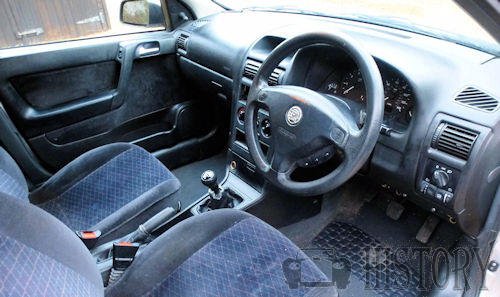
V8 Coupe in DTM
The Astra G series Coupé look was used for the V12 powered dedicated racing cars in the DTM series. These DTM racing cars are purpose built race cars with barely any parts taken from the road cars save for lights or door handles. The car's bodywork featured gull-wing doors that were each supported by two gas struts. The racing cars were powered by 4.0L V8 engines with nearly 500 hp (370 kW). Opel did poorly during several seasons of DTM as only Manuel Reuter placed significantly in the championship once, taking second in the inaugural season 2000. Opel won the 24h Nürburgring in 2003, though.
Body package DTM: 8 × 18-inch alloy wheels in Irmscher Sport Star design with tires 225/35 ZR 18, sport exhaust system twin-flow, front spoiler, grille, rear spoiler, fender widenings, roof spoiler, aluminum pedals
Opel Performance Center (OPC)
"OPC" (for Opel Performance Center ) replaced in 1999 the "GSi" code ( Grand Sport injection ) at Opel for the time being. The first Astra OPC was a 3000 copies limited sports homologation edition of the Astra G. It was delivered only in black, stars silver and arden blue.
He got various suspension and engine components from racing. Among other things, the OPC 1 received a 16-inch brake system with brake cooling as well as modified front wishbones and a more directly tuned power steering. Compared to the standard model, another rear axle was installed, whose lane values, together with the front axle, were matched to only one driver (left front seat). The rear of the OPC 1 is steel-reinforced for greater torsional rigidity.
The 2.0-16V engine was redesigned by the motorsport department to 18 kW more power than the normal version (100 kW to 118 kW). Manifolds , forged pistons, "sharper" camshafts , larger channels and modified software increased performance and should also deepen the overall sporty impression. An oil cooler should keep the oil temperature lower to maintain the important lubricating properties of the oil under high engine loads. A coolant thermostat with 82 ° C opening temperature was also used to lower the coolant temperature compared to the standard engine.
The outer appearance was not changed too much in the first OPC version. In addition to a large tail, which provides zero lift on the rear axle with a drag coefficient (c w ) of 0.30 (like the Porsche 911 GT3 ), a modified front lip, rear muffler, 17-inch BBS alloy wheels and OPC Sports mirror (hagus) installed. The body was also lowered by 20 mm.
Inside there were Recaro sports seats without side airbags or height-adjustable Opel sports seats with side airbag and lumbar support. The most important feature of the interior are the blue seat belts, the skyline blue seat covers and the consecutive numbering of the OPC-1 models in the center console. The instruments in the cockpit were deposited in white as in the variants of the Astra "Sport".
There were two variants for Germany, on the one hand the "Touring" version with anti-theft alarm , power windows, air conditioning, adjustable steering column, central locking (radio) and radio (base price 46,450 DM / 23,749.51 €), and a "Sport" version without the additional equipment of the Touring version, which weighed 50 kg less (base price 42,900 DM / 21,934.42 €). Both versions had the short-stepped F23 sports transmission, which was also in the Opel Speedster, as well as a traction control with intervention on engine and brakes and an on-board computer with integrated check-control system.
From September 2002 there was with the facelift of the Astra G a new edition of the Astra G OPC, which was unlimited.
The outer shape was now lifted from the normal version, modified front and rear aprons, side skirts, sports grill, darkened front and rear headlights are striking changes, the latter also affected the civil Astra variants.
Xtreme
The Astra Xtreme, a concept car presented at the 2001 Geneva motor show, was a single-production V8-powered Astra based on the G-series Astra DTM. Like the DTM racing car, it featured a 4.0 litres (240 cu in) V8 engine, producing 444 hp (331 kW), gull-wing doors supported by gas struts, carbon fiber panels, and race-specification interior with five-point seatbelts.
Stock Car Brazil
The season of 2005 also joined the history of Stock Car. In addition to the category have become multi - the first time the Mitsubishi Lancer ran alongside the Chevrolet Astra, on 30 October 40 cars Stock Car V8 engine performed an unprecedented race outside of Brazil worth points for the championship. It was a round to the side of TC 2000, the main category of Argentina and in July had run in Curitiba (Autodromo Internacional de Curitiba). The Autódromo Juan y Oscar Gálvez received an audience of 70,000 people. Giuliano Losacco was the winner with Mateus Greipel second and Luciano Burti third.
The engine was a V8 Chevrolet 350 imported from the United States by JL, similar to that used in Busch Series, the second category of NASCAR, equal and limited to 450 hp (336 kW). Thus, the automaker GM is now sponsoring the category, providing the fairing of the Astra, making room for other manufacturers could enter the category with low investment.
Motorsport
An Astra won the Andros Trophy for three consecutive years starting in 2000.
An Astra was used in the 1994 Super Tourenwagen Cup season. In 2002, 2003 and 2006, three different drivers were European Rallycross Champions in the Division 2 driving Astras. The 2003, 2004, 2006, 2007 and 2008 runner-ups also raced in that car. Christian Ledesma was 2004 TC 2000 champion with an Astra and Matías Rossi took that title in 2006 and 2007.
The Astra has been used in the shape of silhouette racing cars as well. It was featured in the Deutsche Tourenwagen Masters from 2000 to 2003 (Manuel Reuter was runner-up in 2000) and overall winner of the 2003 Nürburgring 24h race and the Stock Car Brasil from 2004 to 2008 (Giuliano Losacco won the tournament in 2004 and 2005). In 2009, the Astra G body was replaced Stock Car Brasil by a Vectra, which is in fact the same as the Astra H.
The car has also been raced in the Russian Touring Car Championship, the 2004 European Touring Car Championship season, the 2006 Swedish Touring Car Championship season, the 2008 European Touring Car Cup and the 2013 European Rallycross Championship season.
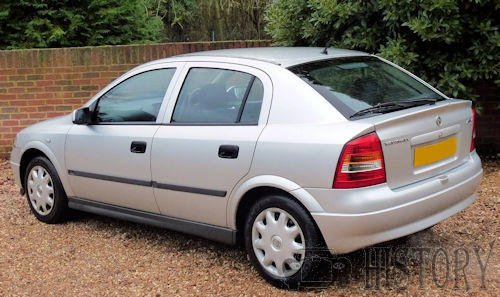
Technical
-
Vauxhall Opel Astra G Technical details and specifications (1998-2009)
DIMENSIONS
Length overall - Saloon 4239mm,H-back 4051mm,Estate 4278mm
Width overall -1852mm
Height overall - Saloon 1410mm Estate 1525mm
Weight—kerb - 1093/1154kg
Wheelbase - 2517mm,
Track—front/rear - Dependent on rim offsetTRANSMISSION
Type - Front wheel drive
Manual gearbox type - 5 speed
Manual gearbox ratios
5 speed 0,89; 1.12; 1,41; 2.13; 3,73; R 3,31 4 speed; AF13 0.74; 1; 1,48; 2.81; R 2.277:1
Drive shafts - With 2 CV joints each
Final drive ratio - 3.551BRAKES
Type - Diagonal dual circuit (opt ABS)
Power assistance - Vacuum servo
Front -Ventilated discs 236x20mm (min 17)
Rear - Drums 200mm (max 201)
Handbrake - Mechanical on rear wheelsSTEERING
Type - Rack and pinion PASSUSPENSION
FRONT - Coil springs/struts, anti roll bar
REAR - Trailing beam with diagonal arms, coil springs, anti roll barCOOLING SYSTEM
Type - Water pump radiator
Radiator pressure cap - 1.20/1.50 bar (18/22 Ibin2)
Fan - Electric
Thermostat - 92°cPetrol engines
model
MKZ *
capacity
power
Torque
(Nm at 1 / min)Consumption ***
(l / 100 km)
totalCO 2 emission ***
(g / km)construction time
comment
variant
1.2 16V
(X12XE)
1199 cc
48 kW (65 hp) / 5600
110/4000
6.1-6.4
147-154
02.1998-09.2000
1,3,4
1.2 16V
(Z12XE)
1199 cc
55 kW (75 hp) / 5600
110/4000
6.1-6.4
147-154
09.2000-07.2004
replaced model year 2001 with the X12XE
1,2,3,4
1.4 16V
(X14XE)
1389 cc
66 kW (90 hp) / 6000
125/4000
7.1-8.3
171-200
02.1998-09.2000
only export models
1,3,4
1.4 16V
(Z14XE)
1389 cc
66 kW (90 hp) / 6000
125/4000
7.2-8.3
173-200
09.2000-07.2004
replaced model year 2001 with the X14XE
1,2,3,4
1.4 16V twin port
(Z14XEP)
1364 cc
66 kW (90 hp) / 5600
125/4000
7.2
10.2003-08.2009
only Astra Classic II (produced in Poland)
2,3,4
1.6 8V
(X16SZR)
1598 cc
55 kW (75 hp) / 5200
128/2800
7.1 to 8.2
171-197
02.1998-09.2000
1,2,3,4
1.6 8V
(Z16SE)
1598 cc
62 kW (84 hp) / 5400
138/2600
7.0 to 8.4
168-201
09.2000-07.2004
replaced model year 2001 with the X16SZR
1,2,3,4
1.6 CNG
(Z16YNG)
1598 cc
71 kW (97 hp) / 6200
140/4200
03.2003-01.2005
last still produced version - beside convertible
4 **
1.6 16V
(X16XEL)
1598 cc
74 kW (101 hp) / 6000
150/3600
7.5-8.4
180-202
02.1998-09.2000
1,2,3,4
1.6 16V
(Z16XE)
1598 cc
74 kW (101 hp) / 6000
150/3600
7.0-8.2
168-197
09.2000-12.2005
replaced model year 2001 with the X16XEL
1,2,3,4,6
1.6 16V twin port
(Z16XEP)
1598 cc
76 kW (103 hp) / 6000
147/3600
7.1
12.2002-08.2009
new engine with swirl flap system
1,2,3,4,5,6
1.8 16V
( X18XE1 )
1796 cm³
85 kW (116 hp) / 5400
170/3400
7.7 to 8.4
185-202
02.1998-09.2000
1,2,3,4,5
1.8 16V
( Z18XE )
1796 cm³
92 kW (125 hp) / 5600
170/3800
7.8 to 8.8
187-211
09.2000-12.2005
replaced model year 2001 with the X18XE1
1,2,3,4,5,6
1.8 16V
(Z18XEL)
1796 cm³
85 kW (115 hp) / 5600
170/3800
09.2000-07.2004
only for some export countries
1,2,3,4
2.0 16V
(X20XEV)
1998 cm³
100 kW (136 hp) / 5600
188/3400
8.3 to 9.6
200-231
02.1998-09.2000
1,2,3,4
2.0 16V
(X20XER)
1998 cm³
118 kW (160 hp) / 6500
188/4300
11.1999-09.2002
only OPC 1
1
2.0 Turbo (16V)
(Z20LET)
1998 cm³
140 kW (190 hp) / 5400
250 / 1950-5300
8.9
214
09.2000-08.2001
5
2.0 Turbo (16V)
(Z20LET)
1998 cm³
141 kW (192 hp) / 5400
250 / 1950-5300
09.2002-06.2003
OPC, until 2002
1,4,5,6
2.0 Turbo (16V)
(Z20LET)
1998 cm³
147 kW (200 hp) / 5600
250 / 1950-5300
12.2002-12.2005
OPC, from 2002
1,4,5,6
2.2 16V
(Z22SE)
2198 cc
108 kW (147 hp) / 5800
203/4000
8.4-8.8
202-212
06.2000-12.2005
replaced model year 2001 with the X20XEV
1,2,3,4,5,6
* Engine identification variants: [1] = three-door, [2] = four-door, [3] = five-door, [4] = caravan, [5] = coupe, [6] = convertible
In 1998, certain engines (X12XE, X16XEL, X20XEV) were delivered with the code number D3 low in pollution, which could be reclassified to D4 with a subsequent certification from the manufacturer to the registration office.
** The 2003 built and 2005 Caravan version with the engine Z16YNG had a natural gas drive
*** Shift, sport or automatic transmission; Sloped and notchback or caravan; Values for the models sold in the Federal Republic of Germany
Diesel engines
model
MKZ *
capacity
power
Torque
at 1 / minConsumption
(l / 100 km)
totalCO 2 emission
(g / km)construction time
variant
1.7 TD (8V)
(X17DTL)
1700 cc
50 kW (68 hp) / 4500
132 Nm / 1800-3250
5.9
158
02.1998-08.2000
Three-door, four-door, five-door, caravan
1.7 DTI (16V)
(Y17DT)
1686 cc
55 kW (75 hp) / 4400
165 Nm / 1800-3000
4.4-4.8
119-130
02.2000-07.2004
Three-door, four-door, five-door, caravan
1.7 CDTI (16V)
(Z17DTL)
1686 cc
59 kW (80 hp) / 4400
170 Nm / 1800-2800
4.4-4.7
119-126
04.2003-01.2005
04.2003-08.2009Three-door, four-door, five-door, caravan
2.0 DI (16V)
(X20DTL)
1995 cm³
60 kW (82 hp) / 4300
185 Nm / 1800-2500
5.7
153
02.1998-09.2000
Three-door, four-door, five-door, caravan
(Y20DTL)
185 Nm / 1500-2750
6.7
181
09.2000-07.2004 (export models only)
Three-door, four-door, five-door, caravan
2.0 DTI (16V)
(Y20DTH)
1995 cm³
74 kW (101 hp) / 4300
230 Nm / 1500-2500
5.7-5.9
151-154
09.1999-07.2004
Three-door, four-door, five-door, caravan
2.2 DTI (16V)
(Y22DTR)
2172 cc
92 kW (125 hp) / 4000
280 Nm / 1500-2750
6.0-6.1
161-169
09.2002-12.2005
Three-door, four-door, five-door, caravan, coupe, convertible
* Engine identification
OPC vehicle data
Astra G OPC
Astra G OPC 2
2.0 16V (X20XER)
2.0 16V turbo engine (Z20LET)
118 kW (160 hp) at 6500 rpm
141 kW (192 hp) at 5400 rpm (until 2002)
147 kW (200 hp) at 5600 rpm (from 2002)
188 Nm at 4300 rpm
250 Nm at 1950-5300 / min
0-100 km / h in 8.2 s
0-100 km / h in 7.3 s
0-100 km / h in 7.1 s
V max 220 km / h
V max 240 km / h
V max 240 km / h
Trim level: UK
- Envoy
- Expression
- .COM
- Active
- LS
- Club
- LS ECO4
- Enjoy
- Sport
- CD
- SXi
- Comfort
- SRi
- CDX
- Elegance
- GSi
- Edition 100
- SE1
- SE2
- Bertone
- 16v
- Linea Rossa
Equipment variants
- Base
- Comfort
- NJoy
- Sportive (later then "Sport")
- Eco (1.2)
- Eco 4 (1.7 DTI, after Facelift 1.7 CDTI)
- Selection (Free, Comfort, Sport)
- Elegance
- Fresh (from 2002)
- Special models:
- Fashion
- Edition 100
- Edition 100 Classic
- Edition 2000
- Edition Silver (Nov. 1998 to Jan. 1999)
- Eurosport (Austria, MY 2002)
- OPC 1 (limited to 3000 pieces, Sep. 1999 to the end of 2001)
- OPC 2 (from autumn 2002)
- Edition Bild (from 2002 on the 50th anniversary of Bildzeitung)
- FC Bayern Munich Edition (limited to 500 pieces, from Feb. 2000)
- Sportsline (based on Sportive, factory-tuned by Irmscher)
- Special models for Convertible / Coupé:
- Edition 90 years Bertone (from the end of 2002)
- Linea Blu (Autumn 2001 to early 2004)
- Linea Rossa (July 2002 to November 2004)
- Daytona (from October 2003)
- Silverstone (from October 2003)
© Motor car History
Service
-
Vauxhall Opel Astra G Service Guide (1998-2009)
Service intervals - 9000 miles
ENGINE:1.6L X16XELType - X16XEL; 4 cyl transverse mounted
Number of cylinders - 4; No 1 pulley end
Cubic capacity - 1598cm
Bore/Stroke - 79/81.5mm
Compression ratio/pressure - 10.5:1
Fuel Octane rating (RON) - Unleaded only
Brake horsepower (DIN) - 100 at 6200rpm
Torque (DIN) Nm (1b ft) - 148 (109) it 3500rpm
Valve operation - OHC in Iine valves hydraulic tappets
Spark plugs make/type - Bosch FRBLDC
Gap - 0.7/0.8mm (028/031in)
Distributor make/type - Distributorless system
Firing order/rotation - 1-3-4-2/anticlockCAPACITIES
Engine oil - 3.25 litres inc filter
Gearbox oil - 1.6 litres; Auto 5.0
Differential oil - Inc G-box
Cooling system - 6.0 litres
Fuel tank - 52 litres
Tyre size - GLS 175/65 R 14; sport 195/55 R 15
Pressures bar (psi) - F (31) R (26)
Max towing weight - 900/1000kg
Hydraulic fluid type - DOT 4 specELECTRICAL
Battery - 12V 44Ah neg earth
Alternator - Delco Remy 70A
Regulated voltage - 14.5v-More Vauxhall Opel Astra G Advanced Maintenance is available for registered users-
© Motor car History
